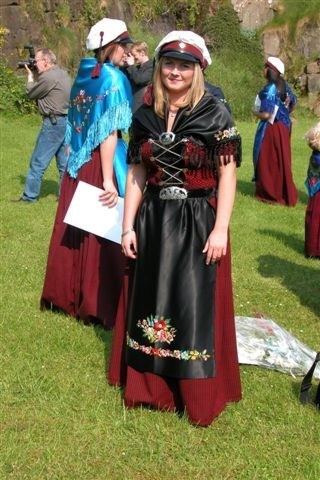 | ||
This article is about the demographic features of the population of the Faroe Islands, including population density, ethnicity, education level, health of the populace, economic status, religious affiliations and other aspects of the population.
Contents
- CIA World Factbook demographic statistics
- Age structure
- Sex ratio
- Infant mortality rate
- Life expectancy at birth
- Total fertility rate
- Nationality
- Ethnic groups
- Religions
- Languages
- Literacy
- References
The vast majority of the population are ethnic Faroese, of North Germanic descent. Ethnic Faroese are, in genetic terms, among the most homogenous groups ever found.
Recent DNA analysis have revealed that Y chromosomes, tracing male descent, are 87% Scandinavian. The studies show that mitochondrial DNA, tracing female descent, is 84% Scottish / Irish.
Of the approximately 48,000 inhabitants of the Faroe Islands (16,921 private households (2004)), 98% are Danish realm citizens, meaning Faroese, Danish, or Greenlandic. By birthplace one can derive the following origins of the inhabitants: born on the Faroes 91.7%, in Denmark 5.8%, and in Greenland 0.3%. The largest group of foreigners are Icelanders comprising 0.4% of the population, followed by Norwegians and Poles, each comprising 0.2%. Altogether, on the Faroe Islands there are people from 77 different nationalities. The Faroe Islands have the highest rate of adoption in the world, despite a relatively high fertility rate of 2.6 children. [1]
Faroese is spoken in the entire country as a first language. It is not possible to say exactly how many people worldwide speak the Faroese language.
The 2011 census, called Manntal, shows that 10% were not born in the Faroe Islands, but of these only 3% were born outside the Kingdom of Denmark. 6.5% of people older than 15 did not speak Faroese as their mother tongue. 33 persons said that they did not understand Faroese at all. According to the 2011 census, 45 361 Faroese people (people living in the Faroes) spoke Faroese as their first language and 1546 spoke Danish as their first language.
The Faroese language is one of the smallest of the Germanic languages. It is most similar to Icelandic and Norwegian. In the twentieth century Faroese became the official language and since the Faroes are a part of the Danish realm Danish is taught in schools as a compulsory second language.
Faroese language policy provides for the active creation of new terms in Faroese suitable for modern life.
CIA World Factbook demographic statistics
The following demographic statistics are from the CIA World Factbook, unless otherwise indicated.
Age structure
0-14 years: 21% (male 5,362; female 4,975)
15-64 years: 64.2% (male 16,837; female 14,788)
65 years and over: 14,8% (male 3,487; female 3,818) (2011 est.)
Sex ratio
at birth: 1.07 male(s)/female
under 15 years: 1.08 male(s)/female
15-64 years: 1.13 male(s)/female
65 years and over: 0.93 male(s)/female
total population: 1.09 male(s)/female (2012 est.)
Infant mortality rate
5.94 deaths/1,000 live births (2012 est.)
Life expectancy at birth
total population: 79.85 years
male: 77.37 years
female: 82.50 years (2012 est.)
Total fertility rate
2.4 children born/woman (2012 est.)
Nationality
noun: Faroese (singular and plural)
adjective: Faroese
Ethnic groups
Faroese (mixed Scandinavian - Scottish)
Religions
Norse Paganism
Languages
The official languages are Faroese (derived from Old Norse), and Danish
People in the Faroe Islands by language in 2011 according to the Faroese census of 2011, named Manntal
Number of all residents of the Faroe Islands who were asked to reply to the questions from Manntal in November 2011: 48.346
Literacy
definition: NA
total population: NA%
male: NA%
female: NA%
note: similar to Denmark proper
